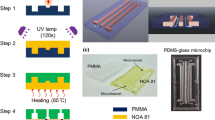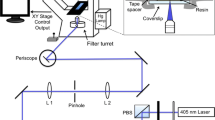Abstract
A commercially available CO2 laser scriber is used to perform the direct-writing ablation of polymethyl-methacrylate (PMMA) substrates for microfluidic applications. The microfluidic designs are created using commercial layout software and are converted into the command signals required to drive the laser scriber in such a way as to reproduce the desired microchannel configuration on the surface of a PMMA substrate. The aspect ratio and surface quality of the ablated microchannels are examined using scanning electron microscopy and atomic force microscopy surface measurement techniques. The results show that a smooth channel wall can be obtained without the need for a post-machining annealing operation by performing the scribing process with the CO2 laser beam in an unfocused condition. The practicality of the proposed approach is demonstrated by fabricating two microfluidic chips, namely a cytometer, and an integrating microfluidic chip for methanol detection, respectively. The results confirm that the proposed unfocused ablation technique represents a viable solution for the rapid and economic fabrication of a wide variety of PMMA-based microfluidic chips.














Similar content being viewed by others
References
Allen JW, Kenward M, Dorfman KD (2009) Coupled flow and reaction during natural convection PCR. Microfluid Nanofluid 6:121–130
Beyor N, Seo TS, Liu P, Mathies RA (2008) Immunomagnetic bead-based cell concentration microdevice for dilute pathogen detection. Biomed Microdevices 10:909–917
Chen HT, Wang YN (2008) Fluorescence detection in a micro flow cytometer without on-chip fibers. Microfluid Nanofluid 5:689–694
Chen HT, Wang YN (2009) Optical microflow cytometer for particle counting, sizing and fluorescence detection. Microfluid Nanofluid 6:529–537
Cheng JY, Wei CW, Hsu KH, Young TH (2004) Direct-write laser micromachining and universal surface modification of PMMA for device development. Sens Actuators B Chem 99:186–196
Choi D, Jang E, Park J, Koh W (2008) Development of microfluidic devices incorporating non-spherical hydrogel microparticles for protein-based bioassay. Microfluid Nanofluid 5:703–710
Chung CK, Lin YC, Huang GR (2005) Bulge formation and improvement of the polymer in CO2 laser micromachining. J Micromech Microeng 15:1878–1884
Fu LM, Lin CH (2007) A rapid DNA digestion system. Biomed Microdevices 9:277–286
Fu LM, Yang RJ, Lin CH, Lee GB, Pan YJ (2004) Electrokinetically driven micro flow cytometers with integrated fiber optics for on-line cell/particle detection. Anal Chim Acta 507:163–169
Fu LM, Leong JC, Lin CF, Tai CH, Tsai CH (2007) High performance microfluidic capillary electrophoresis devices. Biomed Microdevices 9:405–412
Fu LM, Lee CY, Liao MH, Lin CH (2008a) Fabrication and testing of high-performance detection sensor for capillary electrophoresis microchips. Biomed Microdevices 10:73–80
Fu LM, Tsai CH, Lin CH (2008b) A high-discernment microflow cytometer with microweir structure. Electrophoresis 29:1874–1878
Fu LM, Hong TF, Wen CY, Tsai CH, Lin CH (2008c) Electrokinetic instability effects in microchannels with and without nanofilm coatings. Electrophoresis 29:4871–4879
Fu LM, Wang JH, Luo WB, Lin CH (2009) Experimental and numerical investigation into the joule heating effect for electrokinetically driven microfluidic chips utilizing total internal reflection fluorescence microscopy. Microfluid Nanofluid 6:499–507
Hairer G, Vellekoop MJ (2009) An integrated flow-cell for full sample stream control. Microfluid Nanofluid 7:647–658
Heng Q, Tao C, Zho T (2006) Surface roughness analysis and improvement of micro-fluidic channel with excimer laser. Microfluid Nanofluid 2:357–360
Hou HH, Tsai CH, Fu LM, Yang RJ (2009) Experimental and numerical investigation into micro-flow cytometer with 3-D hydrodynamic focusing effect and microweir structure. Electrophoresis 30:2507–2515
Hsieh TM, Luo CH, Wang JH, Lin JL, Lien KY, Lee GB (2009) A two-dimensional, self-compensated, microthermal cycler for one-step reverse transcription polymerase chain reaction applications. Microfluid Nanofluid 2:357–360
Hsu YC, Chen TY (2007) Applying Taguchi methods for solvent-assisted PMMA bonding technique for static and dynamic μ-TAS devices. Biomed Microdevices 9:513–522
Juchniewicz M, Chudy M, Brzózka Z, Dybko A (2009) Bonding-less (B-less) fabrication of polymeric microsystems. Microfluid Nanofluid 7:733–737
Klank H, Kutter JP, Geschke O (2002) CO2-laser micromachining and back-end processing for rapid production of PMMA-based microfluidic systems. Lab Chip 2:242–247
Klavons JA, Bennett RD (1986) Determination of methanol using alcohol oxidase and its application to methylester content of pectins. J Agric Food Chem 34:597–605
Lee CY, Chen CM, Chang GL, Lin CH, Fu LM (2006) Fabrication and characterization of semicircular detection electrodes for contactless conductivity detector–CE microchips. Electrophoresis 27:043–5050
Lee CY, Lin YH, Lee GB (2009) A droplet-based microfluidic system capable of droplet formation and manipulation. Microfluid Nanofluid 6:599–610
Lien KY, Lee SH, Tsai TJ, Chen TY, Lee GB (2009) A microfluidic-based system using reverse transcription polymerase chain reactions for rapid detection of aquaculture diseases. Microfluid Nanofluid 7:795–806
Lin CH, Tsai CH, Fu LM (2005) A rapid 3-dimensional vortex micromixer utilizing self-rotation effect under low Reynolds number conditions. J Micromech Microeng 15:935–943
Lin CH, Tsai CH, Fu LM (2007) Rapid circular microfluidic mixer utilizing unbalanced driving force. Biomed Microdevices 9:43–50
Lin CH, Wang JH, Fu LM (2008) Improving the separation efficiency of DNA biosamples in capillary electrophoresis microchips using high-voltage pulsed DC electric fields. Microfluid Nanofluid 5:403–410
Lin CH, Lee CY, Tsai CH, Fu LM (2009) Novel continuous particle sorting in microfluidic chip utilizing cascaded squeeze effect. Microfluid Nanofluid 7:499–508
Liu Y, Rauch CB, Stevens RL, Lenigk R, Yang J, Rhine DB, Grozinski P (2002) DNA amplification and hybridization assays in integrated plastic monolithic devices. Anal Chem 74:3063–3070
Liu Y, Cady NC, Batt CA (2007) A plastic microchip for nucleic acid purification. Biomed Microdevices 9:769–776
Lund-Olesen T, Dufva M, Dahl JA, Collas P, Hansen MF (2008) Sensitive on-chip quantitative real-time PCR performed on an adaptable and robust platform. Biomed Microdevices 10:769–776
Martynova L, Locascio LE, Gaitan M, Kramer GW, Christensen RG, MacCrehan WA (1997) Fabrication of plastic microfluid channels by imprinting methods. Anal Chem 69:4783–4789
Ohno K, Tachikawa K, Manz A (2008) Microfluidics: applications for analytical purposes in chemistry and biochemistry. Electrophoresis 29:4443–4453
Prakash R, Kaler KVIS (2007) An integrated genetic analysis microfluidic platform with valves and a PCR chip reusability method to avoid contamination. Microfluid Nanofluid 3:177–187
Prakash R, De la Rosa C, Fox JD, Kaler KVIS (2008) Characteristics and impact of Taq enzyme adsorption on surfaces in microfluidic devices. Microfluid Nanofluid 4:451–456
Qi H, Chen T, Yao L, Zuo T (2008) Hydrophilicity modification of poly(methyl methacrylate) by excimer laser ablation and irradiation. Microfluid Nanofluid 5:139–143
Snakenborg D, Klank H, Kutter JP (2004) Microstructure fabrication with a CO2 laser system. J Micromech Microeng 14:182–189
Sundberg SO, Wittwer CT, Greer J, Pryor RJ, Elenitoba-Johnson O, Gale BK (2007) Solution-phase DNA mutation scanning and SNP genotyping by nanoliter melting analysis. Biomed Microdevices 9:159–166
Tran NT, Ayed I, Pallandre A, Taverna M (2010) Recent innovations in protein separation on microchips by electrophoretic methods: an update. Electrophoresis 31:147–173
Tsai CH, Chen HT, Wang YN, Lin CH, Fu LM (2007) Capabilities and limitations of 2-dimensional and 3-dimensional numerical methods in modeling the fluid flow in sudden expansion microchannels. Microfluid Nanofluid 3:13–18
Tsai CH, Hou HH, Fu LM (2008) An optimal three-dimensional focusing technique for micro-flow cytometers. Microfluid Nanofluid 5:827–836
Wei CW, Cheng JY, Young TH (2006) Elucidating in vitro cell-cell interaction using a microfluidic coculture system. Biomed Microdevices 8:65–71
Wen CY, Yeh CP, Tsai CH, Fu LM (2009) Rapid magnetic microfluidic mixer utilizing AC electromagnetic field. Electrophoresis 30:4179–4186
Wu Z, Li D (2008) Mixing and flow regulating by induced-charge electrokinetic flow in a microchannel with a pair of conducting triangle hurdles. Microfluid Nanofluid 5:67–76
Yang CH, Huang KS, Chang JY (2007) Manufacturing monodisperse chitosan microparticles containing ampicillin using a microchannel chip. Biomed Microdevices 9:253–259
Yeh CH, Lin PW, Lin YH (2010) Chitosan microfiber fabrication using a microfluidic chip and its application to cell cultures. Microfluid Nanofluid 8:115–121
Yuan D, Das S (2007) Experimental and theoretical analysis of direct-write laser micromachining of polymethyl methacrylate by CO2 laser ablation. J Appl Phys 101:024901
Zhang L, Gu F, Tong L, Yin X (2008a) Simple and cost-effective fabrication of two-dimensional plastic nanochannels from silica nanowire templates. Microfluid Nanofluid 5:727–732
Zhang J, Das C, Fan ZH (2008b) Dynamic coating for protein separation in cyclic olefin copolymer microfluidic devices. Microfluid Nanofluid 5:327–335
Zhu J, Tzeng TJ, Hu G, Xuan X (2009) DC dielectrophoretic focusing of particles in a serpentine microchannel. Microfluid Nanofluid 7:751–756
Acknowledgments
The authors gratefully acknowledge the financial support provided to this study by the National Science Council of Taiwan under Grant NSC97-2320-B-020-001-MY3 and NSC98-2113-M-020-001.
Author information
Authors and Affiliations
Corresponding authors
Rights and permissions
About this article
Cite this article
Hong, TF., Ju, WJ., Wu, MC. et al. Rapid prototyping of PMMA microfluidic chips utilizing a CO2 laser. Microfluid Nanofluid 9, 1125–1133 (2010). https://doi.org/10.1007/s10404-010-0633-0
Received:
Accepted:
Published:
Issue Date:
DOI: https://doi.org/10.1007/s10404-010-0633-0




